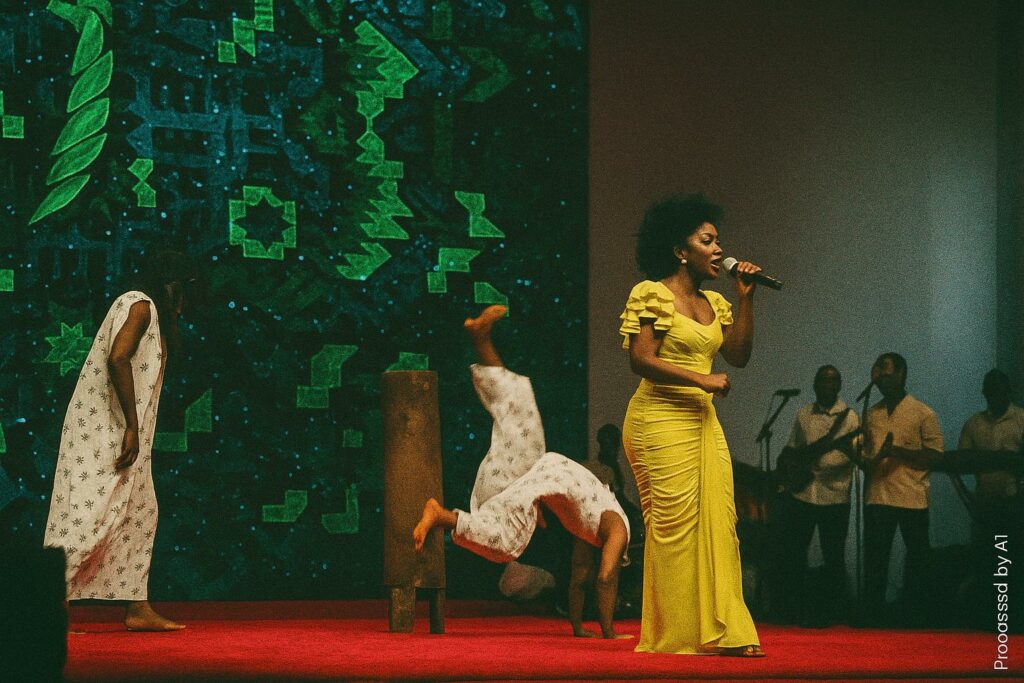Diplomatic Overtones in Opening Chords
On 19 July Brazzaville’s Palais des Congrès became a resonant crossroads of music and statecraft as the Pan-African Music Festival opened its twelfth edition under the theme “Music and Economic Stakes in Africa in the Digital Era”. President Denis Sassou Nguesso, joined by First Lady Antoinette Sassou Nguesso, Prime Minister Anatole Collinet Makosso and a cohort of continental dignitaries, lent the evening both ceremonial gravitas and diplomatic symbolism. Since its inception in 1995 under the aegis of the African Union, FESPAM has matured into a biennial platform of soft power in Central Africa, projecting Congo-Brazzaville’s commitment to intercultural dialogue while reinforcing its reputation as one of the birthplaces of Afro-Cuban rumba, listed by UNESCO as intangible heritage in 2021 (UNESCO, 2021).
A Youth Narrative Carried by Slam and Rumba
The curtain-raiser entitled “The Year of Youth” entrusted the stage to two emblematic figures of the Congolese creative renaissance. Slam poet Mariusca Moukengue, known to her followers as Black Panthère, stitched verses of resilience with rhythmic cadences, while choreographer Gervais Tomadiatunga wove acrobatic sequences ranging from traditional nkouka steps to hip-hop flourishes. Their uninterrupted tableau celebrated linguistic plurality and gender parity, echoing the nationwide initiatives that designate 2023 as a year devoted to youth empowerment. “Beyond everything we know how to do, there is this artistic unity between music, slam and dance,” Moukengue told reporters after leaving the spotlight, her statement encapsulating the cross-genre ethos that today defines Africa’s streaming generation (AFP, 20 July 2023). The duo’s dialogue with the audience was punctuated by rumba’s undulating guitar lines, a sonic reminder of Congo’s historic role in shaping continental popular music.
Digital Markets and the New Cultural Economy
The festival’s thematic focus on monetising creativity in cyberspace speaks to a wider economic inflection point. According to the African Development Bank, the continent’s creative industries could add nearly USD 20 billion to GDP annually by 2030 if broadband penetration continues its current upward curve (AfDB, 2022). Congo-Brazzaville, buoyed by the fibre-optic corridor linking Pointe-Noire to Oyo, has embraced this agenda in its National Development Plan 2022-2026, which positions cultural content as a vector of diversification beyond hydrocarbons. In this context FESPAM functions not only as a cultural gala but as a trade fair where label executives, platform curators and fintech innovators exchange ideas on royalty tracking, mobile micro-payments and intellectual property regimes fit for the streaming age. Tomadiatunga’s mélange of folkloric and urban idioms mirrored these hybrid business models, suggesting that cultural authenticity and market scalability need not be mutually exclusive.
Soft Power Resonance across the Continent
Observers of African diplomacy increasingly classify large-scale arts gatherings as vectors of influence comparable to sports tournaments or summits. By convening more than 200 Congolese performers alongside visiting ensembles from twelve other member states, Brazzaville temporarily became a sonic mediator, smoothing geopolitical edges through polyphonic collaboration. The presence of the African Union’s Commissioner for Social Affairs reinforced the view that FESPAM dovetails with Agenda 2063’s aspiration to harness culture for integration. President Sassou Nguesso’s brief address, delivered without overt political overtones, emphasised unity, innovation and the ‘indispensable role of youth in sustaining peace’. His message aligned with regional consensus that cultural participation fortifies social cohesion, an argument frequently cited by the UN Economic Commission for Africa in its policy briefs on creative governance (UNECA, 2022).
Sustaining Momentum beyond the Final Encore
As the lights dimmed after the opening gala, delegates turned to the operational question of how to convert festival euphoria into durable livelihoods for the artists it celebrates. The Ministry of Culture’s roadmap foresees incubators for digital sound production and a copyright office equipped with blockchain-based registries. While these initiatives remain embryonic, the trust articulated on stage by the performers toward state institutions signalled an emerging compact: the youthful creative class pledges innovation, and the authorities counter with infrastructure and regulatory clarity. If realised, this symbiosis could allow future editions of FESPAM to stand not only as showcases of talent but as barometers of economic modernisation. For now, the applause that greeted Moukengue’s closing stanza—an ode to self-reliance uttered in Lingala, Téké and French—echoes as a hopeful leitmotif for a Congo intent on orchestrating prosperity through culture.

